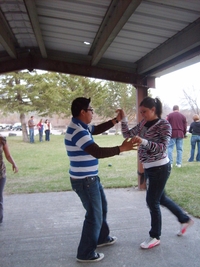
Merengue
 Birthplace: Dominican Republic
Birthplace: Dominican Republic
Creation date: late 1840's
Creator: unknown
Dance type: American Rhythm
The Merengue comes to the dance world from the Dominican Republic. It is considered the Dominican national dance. There are two folk stories as to the origin of the style of the dance.
1) Slaves, who were chained together by ankles, would use this "walking style" as they cut sugar cane to the beat of the drums.
2) A great hero, (sometimes said King or General) was wounded in action, and upon his return a great party was thrown in his honor. This hero/king loved to dance and tried to dance at the party, but was not able to with his wounded leg. The best he could do was limp and drag his wounded leg through the dance. The other dancers feeling sorry for him and not wanting to offend, limped and dragged just like he did.
No one knows if one of these stories is the true origin, but both of them are widely circulated.
The Merengue emerged in the 1840's replacing the popular Rumba. The national news paper began a smear campaign again the Merengue, and for a while, it was shunned by the upper classes. However, due to its joyful spirit and upbeat music, the Merengue was accepted by all Dominicans.
The original dance was fast and agitated, while the newer (1950's and up) ballroom version is much slower and uses hip movements. The Merengue was introduced to the United States in the 1950s. The original folkloric version is still danced in some of the remote and rural areas of the Dominican Republic.
This work is credited to BYU-Idaho dance book 2006.
Call Kevin Hunter 208-870-6737 EMail: captindanceman@yahoo.com















